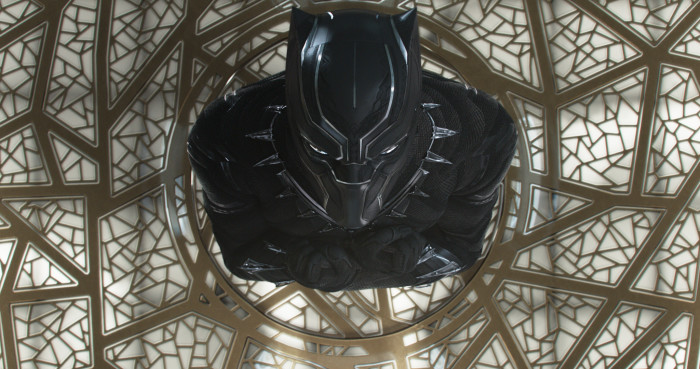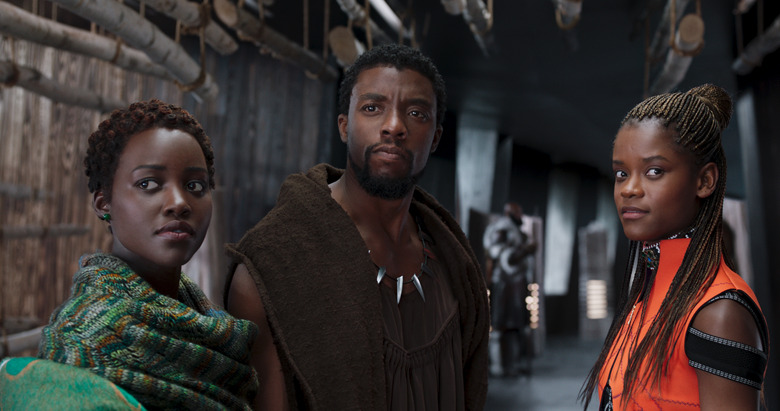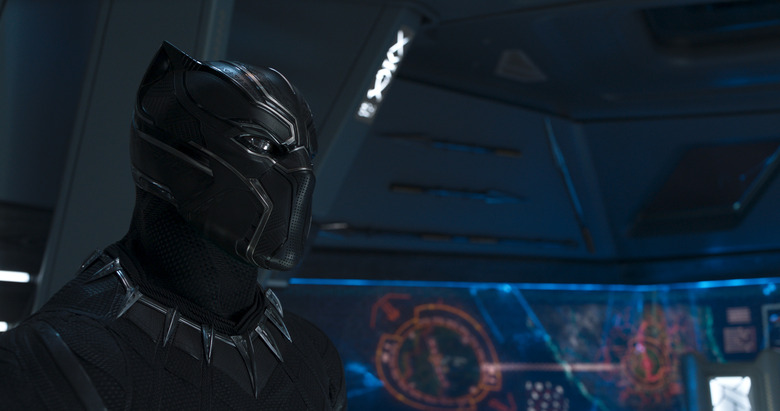Finding Black Panther: Why Marvel's African Superhero Matters Now More Than Ever
You don't know me, but picture this: a smallish black boy, aged anywhere between 7 years old and 18 years old (because really, in my mind I grew very little growing up) on the floor of his small bedroom with my back propped against the small toy-box chest in my room. If you're flying above me, looking down, you'd see me slightly hunched over and all around me, comic books fanned in a messy array all over the floor around me. You'd see me studying and reading each one, sometimes holding two comic book issues up, one in each hand, at the same time, making sense of where they should go, then slipping them, one by one, into a protective case to stay fresh and new.
A History With Comics
Most collectors or readers kept their comics in sequential order but I kept mine grouped together according to storylines that I liked, or artists that I loved, meaning you might have the X-Men storyline "Inferno" grouped together, but might also have a separate grouping for artists like Dale Keown, Jim Lee or Tim Sale. It meant that I had my own obsessive archive of comics; a collection of adventures and explosions, dramas and deaths that were ordered and mattered according to my own, arbitrary, but sensible to me, order. You wanted to see a run of Todd McFarlane's artwork transition from "Amazing Spider-Man" to "Spawn"? I got you. What's that? You didn't know that the X-Men once stepped through the Siege Perilous and had their identities and lives wiped for awhile after a long stretch living in Australia and battling cyborgs while befriending an Aborigine with teleportation powers (yes; that's all correct)? Here you go.
I could find anything during that time; my physical collection of comics tipping somewhere in the 5,000 range by the time I went off to college. I found money wherever possible, found big and small comic book conventions all around the tri-state area, and when they weren't happening, I'd go to local comic books stores in the Trenton, New Jersey area that I grew up in, plumbing through the long boxes and bins in stores like "Thunder Road Comics" or "Steve's Comic Relief" to find back issues that I was missing.
This a la carte approach is what also helped me to form an identity connection through superheroes even though they rarely looked like me. I took a bit of Parker Luck and pulled that close because I got the idea of what it was like to be socially and romantically unpopular in school. I snatched pieces of X-Men here and there, because I knew what it was like to want to just be, but still have to live in a default setting where the world was predisposed to hate and mock you because of who you are.
Back to my bedroom. Trace along the wall and there's a bookcase; it's full of book ranging from Stephen King to George Saunders to J.R.R. Tolkien to Toni Morrison. Their paperback spines are brand-new looking still, but they're likely hard to see; there's an assortment of action figures standing guard in front of them. Batman (the Keaton '89 version); a Wolverine (in his classic blue-and-yellow costume) with hooked retractable claws; a Spider-Man (with splayed open hands and plastic scabs where suction cups were on his hands and knees); a Captain America with a broken shield. And more. Plenty more figures from D.C and Marvel standing close together in an assemblage of capes and masks and crossover make-believe. All handpicked as the heroes that I wanted to be or admired; figurines that I found at comic shops, toy stores, conventions and big box stores like K-Mart.
I share all this to say that I knew and loved comics deeply — as shelter, as identity, as adventure — and in many ways still do. But for all that I did to dig deep and find so many great lessons about courage, friendship, morality, identity and philosophy, it took me years to find The Black Panther.
The Superpower of Invisibility
He wasn't one of the heroes that I read growing up, back when my comic book reading diet composed of X-Men, Spider-Man, Batman and Superman. Those stayed in a tight orbit for most of my life, with the occasional trending title (Captain America, Spawn, Justice League, Avengers) popping onto my radar for a short amount of time because of storyline ("Captain America—dies!") or creative teams that were driving storylines and making them feel worthy of plunking down a couple of dollars. He wasn't in the spinner racks of grocery and convenient stores; I couldn't conjure him up by turning those metallic holders while we waited in line. He wasn't in the churn of Saturday morning cartoons; no Amazing Friends to hang out with; wasn't part of a Sunday morning block of cartoons like Fantastic Four, Iron Man and The Incredible Hulk. And until recently, he wasn't in movies.
Growing up, he appeared in the background of all-heroes-gathering shots against Thanos or Galactus. He occasionally appeared as the guest star in some of the other comics that I was reading; his presence always a mixture of confidence and aloofness that made him mysterious and sometimes cold to me. I was the eldest black child in a divorced family; my parents splitting very early on and my sister and I raised primarily by our mother and her village of support — a younger sister, doting, spoil-prone parents and a host of friends and co-workers we affectionately called "Uncle"-this or "Aunt"-that. It was easy, as a result, to identify with cast members found within the pages of Uncanny X-Men and Spider-Man comics; a series of misfits who felt miscast in society and made a patchwork of a community, a family out of an assortment of relationships.
I was also hampered by the sort of low-confidence and shyness that made me the enviable target of that two-headed mutant of teacher pity and peer ridicule. I was my own sort of Morlock, retreating to the under-dwellings of other kids like me during my middle and high school years — the misfits that did things like marching band, debate, had their "own table" during lunch. In the locker room, where I felt I was surrounded by Herculean bodies, I either got stars for my early arrival or amassed tardies to gym class, contorting my schedule in any way possible to avoid having to get dressed and undressed around my peers. And when the day ended, I often opted not to take the middle school bus home and would instead walk the distance to my grandmother's house. In high school, I was lucky enough not to walk home alone most days, walking through the Ewing, New Jersey neighborhoods with a plucky best friend.
But yet and still, my childhood and teenage years were about developing my superpower of invisibility. Little seen, little catastrophe, I wanted to get in and out of social situations and avoid as much attention as possible. I also wanted to be seen though; by cool kids, by girls that I liked, by anyone, really.
Finding Black Panther
Yet it's all the more reason that I should've found the Black Panther as a kid. T'Challa should have been the obvious answer to many of my social ills as a black kid; an appropriate counter-balance to all the things that I didn't see in myself. A cool confidence, an amazing intellect, a tribe of friends and followers, the respect of his superhero peers. And literally and figuratively black on the inside and out: an astonishingly simple but effective black costume, underneath which stood T'Challa, the African King of Wakanda, feared and envied by everyone in the Marvel Universe. But still, I never found him. His series were too inconsistent and often under the radar to grab my attention, not making the splash cover of Wizard magazine or in industry news bulletins with the same fanfare as the latest costume change, identity reveal or crossover.
He had other problems for me, too. There was the name itself; immediately conjuring up what had been fed to me for years — an army of African-Americans who were militant, violent "troublemakers" that were more interested in disrupting the peace of a more "stable," "civilized" society. It was obviously a skewed narrative, but it didn't help the comic character's association in my mind. Then there was the costume. His seemingly ever-scowling black mask, smallish eye holes and claws, draped in black, he looked menacing and almost evil. He was a stark contrast to the bright-colored costumes of the other heroes that I read who, even if they had surly personalities, still lived them out in blue, yellow, red and green uniforms. They had large eyes or quippy sayings; sidekicks and iconic vehicles.
But Black Panther felt largely rendered invisible; everything about him black inside and outside, with stories taking place in Africa with other characters with their own 'challenging' names. His addition has always been 'cool'; a validator of someone's comic, scene or situation. It was the similar reaction that I had when seeing the live-action version of Black Panther appear in Captain America: Civil War: "cool".

In preparation for his re-emergence, as usual Marvel ramped up their attention towards the character; getting first one, then two series penned by Ta-Nehisi Coates, the race relations writer made famous for his work in The Atlantic and through his book "Between the World And Me". The first, simply titled "Black Panther" is now about four volumes deep, and worth a read for Coates' stellar prose and nods to both history and hip-hop, and his frequent collaborator Brian Stelfreeze, who draws much of the series. It's the first for the character since having a 3-year title run from 2005-2008 and 2010-2012's "Man Without Fear" run, while still maintaining the ability to be a fixture here and there in an assortment of other storylines. The other "Black Panther and The Crew" which featured T'Challa along with a host of other black superheroes like Storm, Luke Cage and Misty Knight, was a notoriously short-lived run, lasting only six issues before being canceled by Marvel. It was a move that invited a great deal of criticism about both the company and the industry itself for its wavering commitment to diversity in both characters and creators as "The Crew" befell a similar fate to the Roxanne Gay written spinoff series "World of Wakanda," which also lasted six issues before being canceled.
But now the movie is upon us, and there's a renewed energy around the character all over again, spawning two more titles in the last few months to capitalize off of the wild momentum and obsession that the movie has created after a series of trailers have stirred the pot of excitement to boil over. It's a reminder that its appeal and anticipation is unique; a crossover film that has come at the right time, when many in society are calling for not only greater diversity, but greater humanity and justice in our everyday lives. To be able to revel in the power of identity, to demand to be seen.
With all this comes the opportunity for a new generation and new fanbase to find the character and his world again and restate the Panther's cultural, pop and social, importance to the world. It means there's a potential to for the movie to spur a renewed commitment by the publisher to be less hasty about canceling. It also means that everyone involved has to figure out how to balance a future that's both on-screen and perhaps on tablet, driving people to find ongoing stories about the character via the digital comic book world. If it happens, there's less need for kids to have to fish for a hero that looks like them. To dig around the bins and look for missing stories, issues and identities. It will serve as a new guard protecting the importance of Wakanda, preventing the demise on screen and in the editorial room.
After all Wakanda, as the story goes, has never been conquered.


